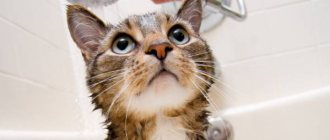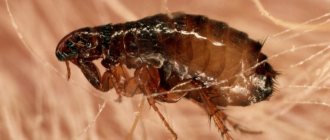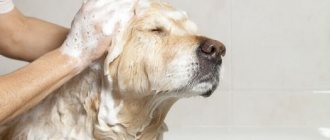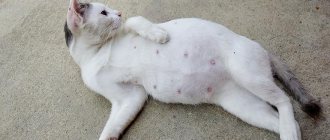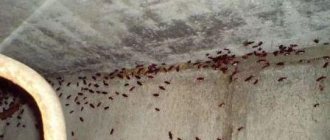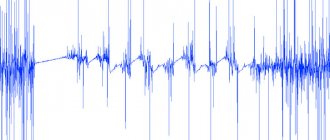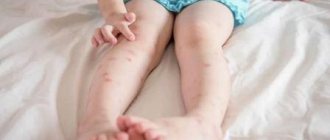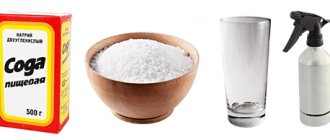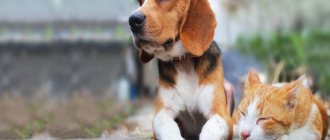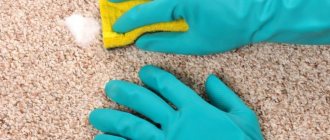02/20/2018 Category: Fleas Author: Irina Litvinova
A good housewife will always have a piece of laundry or tar soap in her house. They are good for removing various stains, treating dandruff and even some diseases of the reproductive system, but few people know about the ability of this product to get rid of fleas. Along with them, dust soap also destroys parasites well. It would seem that such cheap, completely unremarkable chemical products, but they solve so many problems in no time. What is their secret?
- 2 Tar soap
- 3 Dust soap
- 4 Treating cats with soap
- 5 Washing dogs with soap
- 6 Precautions when using soap
- 7 Treating premises with soap against fleas
Laundry soap
Laundry soap in the Soviet Union was made according to certain standards and was available in every home: it was used for washing dishes, washing clothes, washing the body and head. One inexpensive soap replaced a huge number of different detergents. This is due to its composition.
Laundry soap contains only sodium or potassium salt and fatty acids. If you add dyes and essential oils to them, you can get toilet soap. If you add various thinning components and, for example, SLS, you can get a well-foaming shampoo alternative. Thus, only two components included in laundry soap are the basis of any cleaning chemical product, so it was used wherever possible.
Laundry soap indicates the percentage of acids
Laundry soap has a percentage designation: 72% means that the product contains the maximum amount of acids. This is a natural, environmentally friendly soap.
The saturated fatty acids included in this product (stearic, palmitic, lauric, and so on) improve the properties of soap to form foam and exhibit washing abilities in both cold and hot water.
If your hands remain sticky after using laundry soap, it contains rosin. This substance promotes the formation of foam and dissolution of the product in cold water, and also increases the shelf life of the soap. If you add sodium silicate to the product, the stickiness will disappear.
If you add bleach to laundry soap, it will turn white.
Now liquid laundry soap has appeared on the market, which has nothing in common with solid laundry soap except the name. It contains toxic substances that can corrode the skin.
Laundry soap not only cleans surfaces well from dirt, but also has antimicrobial properties, so it is often used in medicine in the absence of certain drugs.
After washing the wound, you need to apply gauze soaked in a soap solution. on the wound
Advantages of this product:
- environmentally friendly hypoallergenic product;
- high alkaline balance;
- has antimicrobial properties;
- low cost;
One of the advantages and disadvantages of this product is that due to its high alkaline balance, this soap cannot be used often for washing: alkali harms the skin, and the epidermis loses its elasticity and becomes dry.
Laundry soap has a rather specific smell that is unpleasant even to people, not to mention various insects. Small parasites (for example, fleas) will try to quickly run away from the source of this “amazing aroma.” Laundry soap does not destroy insects, it only repels them, so they can leave your pet, but they will jump around the bathtub and clothes - here you need to kill them.
Also, do not forget that our pets have a different pH level, so their skin may experience irritation from using laundry soap.
against fleas, I can recommend to you (based on my experience) a common, well-known and also very economical remedy called “Laundry Soap”, by the way, it is good at removing not only fleas from animals, but also lice and nits from people.
ksenko
https://www.lynix.biz/forum/kak-izbavit-koshku-ot-blokh-isklyuchiteln0-narodnymi-sredstvami
Compound
Detailed composition of the product:
- fatty acids (palmitic acid gives hardness to a bar of soap, lauric acid promotes high-quality washing even in cold water),
- alkali or otherwise - sodium (provides stain removal when washed),
- kaolin or otherwise - porcelain clay (the presence of this ingredient prevents the negative effects of alkali on human skin),
- rosin (used to increase the shelf life of soap),
- sodium silicate (neutralizes stickiness from rosin),
- lard and soapstock (gives brown color).
Reference. The more fatty acids a soap contains, the better it removes stains, even old ones. The maximum content is 72%.
Tar soap
Tar soap occupies a special place among cosmetic cleansers. Outwardly, it resembles ordinary laundry soap, but it has a different smell - birch tar, very pungent. Tar makes up approximately 10% of the total composition of the product; everything else is sodium chloride, water, palm oil and fatty acids. They ensure good latherability of the product, and the essential oil softens the effect of alkali.
Tar soap looks similar to laundry soap, but may be a little darker
Tar soap is used mainly to combat small parasitic insects (lice, fleas), which are repelled by its pungent, disgusting smell. But this product has two very useful properties: it heals well and disarms wounds. Parasites feed on the blood of humans and animals, secreting their saliva into our body, which causes an allergic reaction in the form of a burning sensation and rash. For animals, this is unbearable pain; they try to tear the sore spot with their claws, wounds form into which various microbes and bacteria can penetrate, causing inflammation. Tar soap disinfects areas of the skin damaged by pests, reduces pain and itching, and makes it easier for your pet to endure the consequences of the lives of its “inhabitants.”
Tar soap can drive away insects and relieve their bites
Benefits of tar soap:
- environmentally friendly product;
- high alkaline balance;
- has disarming and calming effects;
- low cost;
The disadvantages of this product include:
- contraindication for allergy sufferers: an allergic reaction to tar may occur;
- It is contraindicated for people and animals with thin and dry skin: the skin will become even drier, irritation may occur, even small open cracks;
Tar soap does not kill parasitic insects, it only scares them with its smell, and they escape from the pet’s fur. However, their eggs remain, from which new individuals subsequently hatch, capable of reproduction and parasitism, so you will have to wash your pet with tar soap several times.
Fleas run away from the smell of tar soap, but their eggs remain, so several procedures are needed
Animals have a more delicate sense of smell than people, so the smell of tar soap may be unpleasant to them - you should not leave soap suds on your fur for very long.
Soap dries the skin a little. But only those dogs who have very short and soft hair. For sphinxes or hairless crested animals (CHS) and similar animals, I would not recommend using this soap for bathing. Dries your skin in one go. It dries, not because it’s bad, but because it disinfects and kills germs. Soap acts as an antiseptic and has a positive effect on the skin of animals. But only for dogs and cats! Under no circumstances should you wash rabbits, mice or other animals! Tar soap contains birch tar. No unhealthy fragrances or additives. Clean product! If you are ready to endure the tar smell and are familiar with it, then feel free to buy this soap) It seems to me that it is much more effective than Celandine shampoo. Well, the fact that soap will rid your pet of fleas is a nice addition!
Ksyusha25
https://otzovik.com/review_1135246.html
How to use soap
Getting rid of lice with tar soap is quite simple. There are two methods - combing the hair with a comb and using medications aimed at fighting parasites.
Soap and combing hair with a comb
- wash your hair without leaving the product on the strands for a long time to remove fat and dirt,
- apply soap for head lice to hair, rub until foam appears, leave for 30 minutes - an hour,
- wash your hair thoroughly without using shampoo,
- Separate the strands and comb them thoroughly using a lice comb.
Soap and combing hair with a comb
This folk method is effective in combating parasites after the first use, but in order to completely get rid of lice and the scalp has healed, the procedure must be repeated daily for 5-7 days.
On a note!
While holding the foam composition on your head, it is recommended to cover yourself with a special bathing cap or a plastic bag, wrap it with a towel on top, creating a steam room effect inside.
Tar and lice medicine
You can remove lice with tar soap without combing them with a comb. Another method of using birch pomace involves the simultaneous use of specialized drugs with an insecticidal spectrum of action and a folk remedy.
- the head is treated with a medicinal product against lice (in the manner specified in the instructions for use),
- wash your hair without using cosmetics,
- lather soap on hair, leave for half an hour,
- wash off.
Important!
Before using a medication to treat head lice, consult a doctor. Many medications have a number of contraindications and can cause allergies.
It is recommended to use tar against lice and nits for a month, 1-2 times a week. This is especially true in cases where lice were found in a child who is in close contact with children in kindergartens and schools and can very quickly become infected with lice again.
Dust soap
Dust soap is a regular laundry soap that contains dichlorodiphenyltrichloromethylmethane (DDT for short). This is a toxic substance that can penetrate the chitinous cover of insects. DDT accumulates in the body of an arthropod and, at a certain concentration, kills the pest. That is why it is often used to combat lice and fleas.
DDT can kill parasites on the human body
A special feature of DDT is its ability to penetrate through the shell of eggs, not only through the chitinous cover, so the poison accumulates in the body of unhatched “cubs”, thereby destroying the entire population of parasites at once. Thanks to this, dust soap is more effective than many other products.
In addition to this poison, dust soap has a sharp, terrible odor that frightens insects and makes them run away from the source of this “aroma.” Thus, the parasites leave the body of an animal washed with dust soap either alive, frightened by the smell, or dead - straight to the next world.
DDT will kill even a malaria mosquito
DDT perfectly destroys not only lice and fleas, but also other insects. For example, thanks to this substance, it was possible to save about 10 million people in India from a malaria epidemic carried by mosquitoes.
If you need to wash an animal or person at least twice with laundry and tar soap, then one procedure with dust soap is enough. Moreover, doctors strongly discourage frequent use of this product, since DDT accumulates in both the human and animal body, which can lead to intoxication.
Dust soap looks similar to laundry soap
Dust soap is strictly prohibited for use by pregnant women (both women and female animals), since DDT can cause various pathologies in the fetus. Also, it cannot be used for children (in the case of animals - up to one and a half months), since the substance can disrupt the functioning of the nervous system and brain. Children's immune systems are weak and there is a risk of developing cancer.
Benefits of this soap:
- with one-time use it has a calming effect;
- penetrates the chitinous cover and shell of insect eggs, killing them;
Disadvantages of this product:
- high level of toxicity;
- DDT can accumulate in the human and animal body and lead to serious damage to many body systems;
- dangerous for children (both human and animal);
We tried all the remedies in the veterinary pharmacy. Dust soap for 6.50 UAH. the only thing that killed all the fleas))) The packaging says what to do and how to do it. No sprays, drops, or collar helped. No matter what anyone writes about other means. Everything else is a waste of funds! Dot.
nata
https://www.woman.ru/home/animal/thread/4312013/
Herbal remedies
Sagebrush
Silver wormwood is used against fleas. Thanks to the leaves and stems of a silvery color, this species is distinguished from common wormwood, which does not act on fleas. But it is worth considering that wormwood slightly stains white fur with a greenish tint.
Chopped grass (1 tbsp) is poured with vodka (1 glass). After 2 weeks of infusion with periodic shaking, the tincture is rubbed into the dog’s skin. It is also added to water when washing floors, and sprayed on areas where parasites accumulate.
Garlic
Wormwood and garlic are effective against fleas. 20 grams of dry herb (or 40 g of fresh) are poured with boiling water (0.5 l) and boiled for 15 minutes. Cool.
Chop a couple of cloves of garlic, add 0.5 liters of cold water and leave overnight to infuse. In the morning, a decoction of wormwood and garlic tincture are combined. The resulting product is used to wipe the dog's fur. Garlic is toxic to her, so her attempts to lick the fur should be stopped.
Garlic infusion can be used to separately wipe the head and neck area so that the dog cannot lick off the substance that is harmful to it. Two finely chopped garlic cloves are poured with a glass of water and left for 8 hours.
Onion
Dissolve laundry soap shavings in a glass of water, add finely chopped onion. The mixture is kept on the dog’s body for 5 to 10 minutes and washed off. If necessary, the process is repeated.
Treating cats with soap
Cats are very finicky creatures who do not like to take baths. If households who do not go outside are unlikely to catch any infection, then street revelers are very susceptible to this, and after each walk they need to be washed and treated. After all, if they have worms, people can also become infected with helminthiasis.
Cats have a special relationship with water: don’t touch this wet liquid! There are, of course, exceptions who love to swim, but they are too few.
Some cats favor baths
Therefore, washing a water hater usually requires two adults - one holds it, the other washes it. In addition, you must follow a number of rules for bathing cats:
- before bathing, you need to heat the bath so that it is not cold, and fill it with water so that it is up to your pet’s chest; if you have a basin, fill it with warm (38–43 degrees) water (so that it only reaches the cat’s chest) and place the cat in it; Do not wash in a cold bath or with cold water - the pet may get sick;
The cat must stand firmly on its paws, the water must be up to its chest, not higher, so as not to choke. - water should not get into the ears, eyes, nose and mouth; It is quite enough to wash the entire body except the head;
- you need to be extremely careful with the stomach - this is a very delicate area, behind which vital organs are located, and powerful jets of water into this area can trigger the animal’s instinct of self-preservation;
The stomach of cats is a very delicate and important area, you need to be very careful with it, especially if you wash the cat from the shower - some cats are very restless in the water: they can break out, some reach the taps with their paws and can accidentally turn them, trying to get out, this should not be allowed - either the water will be too hot or too cold, which will harm both the animal and you;
A frightened cat can easily turn on the taps and let in very hot or too cold water. - after the bath, the cat must be wrapped in its own towel so that the water is absorbed into it;
The less water on a cat's fur, the faster it will dry and the less likely it is to get sick. - place the pet in a warm place (to the radiator, pick it up or send it to the balcony under the hot rays of the sun) - it should not freeze;
These are the basic rules for bathing a cat. As for the actual washing, everything is quite simple:
- First you need to wet the animal’s fur (you don’t have to touch the head).
- Lather the bar of soap until it lathers.
- Rub the wool with this foam. Soap should not get into the mouth, nose, ears and eyes; To do this, do not wash your pet’s head, keep it elevated so that foam from the neck does not get into the mouth.
- Wait 3-5 minutes for the soap to take effect. The pet should not lick itself at this time - if soap enters the body, it will cause poisoning.
- Rinse off the foam thoroughly.
- Wrap the cat in a towel and let him warm up.
If laundry and tar soap can be used for pregnant and lactating cats, then dust soap should absolutely not be used for them.
Small kittens (up to a month) cannot be washed with any soap, and dust can only be used after one and a half months.
Cats should be washed with laundry or tar soap at least twice with a 4-7 day interval between procedures. If you use dust soap, once is enough.
Bathing a cat with soapy water
The process of bathing a cat is difficult, since these animals are terribly afraid of water (with rare exceptions). Bathing your pet with tar soap will cause him even more inconvenience because the smell is too strong. In this situation, you cannot do without an assistant.
Bathing rules:
- Prepare a bath or basin with water, a towel and soap in advance.
- Check the water temperature – it should correspond to the cat’s body temperature.
- Put mittens on your hands and your assistant's.
- Wet the animal's fur and thoroughly soap it.
- It is easy to massage your pet so that he is not afraid.
- After 10 minutes, start rinsing off.
- If you see that the fleas are moving, you should repeat the manipulations.
- Wrap the cat in a towel.
The best drugs and folk remedies for getting rid of fleas from a cat
On a note! Prepare a soap solution or thick foam and apply to the animal. It doesn't hurt the animal that much. You can quickly bathe your pet in a soapy solution.
Washing dogs with soap
With dogs, the situation is much simpler - they are not afraid of water, they themselves climb into it when they see it on the street, even when it’s cold. Therefore, taking a bath for a dog should not cause any problems, but it is worth remembering the characteristics of small dogs: they are very weak, they do not have thick hair, so they, like cats, need to be washed in warm water in a pre-heated bath so that they do not freeze .
Small dogs should not be washed in cold water
The process of washing dogs with soap is as follows:
- It is necessary to wet the animal’s fur (you also don’t have to touch the head).
- Lather the soap until a large amount of foam forms.
- Rub the animal's fur with this foam. Soap should not get into your eyes, nose, ears or mouth.
- Wait a few minutes, then rinse off the soap thoroughly.
- If the dog has thick, long hair, you need to lather it again with soap and wait a few minutes, then rinse it off.
Dogs with dry and thin skin should be washed with extreme caution. Dust soap can be used only once every few weeks, so that DDT does not accumulate in the body, and tar and laundry soap can be used several times in a row, with a difference of several days.
Lavender and chamomile
A gentle way to soothe your pet's skin—and maybe even help him or her get some sleep—lavender is actually a powerful, fast-acting flea killer.
In fact, some studies have shown that mixtures containing diluted lavender were as effective at killing fleas as commercial chemical sprays.
To use lavender at home, let fresh lavender soak in water overnight before straining the liquid and spraying it onto your cat's fur (no need to rinse).
Another compound known for its skin-soothing properties, loose chamomile tea can also be used to attack fleas on your feline friend.
Simply brew the tea and, when completely cool, apply the liquid to your cat's fur. You can repeat both procedures daily for as long as necessary.
Precautions when using soap
The most important thing to remember is that soap should not get into your eyes, nose, ears or mouth. It should not be in the ears, because the animal will not allow it to be washed out of there. To prevent foam from getting on the mucous membrane, do not wash your hair - just wash the rest of your body.
Foam from your ears is very difficult to wash out, so try not to get it in there.
You should know about what kind of skin your pet has: you cannot often use laundry and tar soaps if the animal has thin and dry skin - there will be irritation, the skin will become overdried, and may crack.
While laundry and tar soap can be used several times, dust soap should never be used: DDT accumulates well in the body and can even lead to the death of a pet. Therefore, if dust soap does not help get rid of fleas, you need to try another remedy rather than experiment with your animal.
If dust soap does not help, use other means, for example, wormwood essential oil - fleas are afraid of it
Soap can only be used for cats and dogs; Hamsters, mice, rabbits and other pets cannot be washed with soap - it is poison for them. Also, you cannot wash kittens and puppies with soap for up to a month (if we are talking about dust, then up to a month and a half).
Apple cider vinegar is a helper in getting rid of fleas
In its pure form, this product cannot be used on animals.
Therefore, before use, vinegar is diluted with water at room temperature at the rate of 1 part vinegar to 3 parts water. The resulting solution is generously treated with the animal’s body (entirely) and left for 1 hour. The pet is then bathed and combed with a fine-tooth comb to remove paralyzed insects.
Should they wash an animal without parasites with it?
Soap can also be useful for those animals that do not have any problems with fleas. It is not for nothing that tar is used in shampoos, solving the following problems:
- reduces and even gets rid of dandruff,
- removes soreness of the skin under the hairline,
- reduces hair loss
- accelerates growth and increases density.
Many women speak of this remedy as miraculous, helping when expensive shampoos have stopped working. Shampoo will have exactly the same effect on your pet’s fur, which is why even today many owners abandon professional dog products in favor of tar soap.
In addition to the positive aspects already described, long-haired breeds will find it easier to comb. And short-haired dogs will be able to boast that their coat becomes thicker and tougher. The most important thing here is not to dry out the coat and skin with too frequent use; otherwise, tar soap will make the dog healthier.
